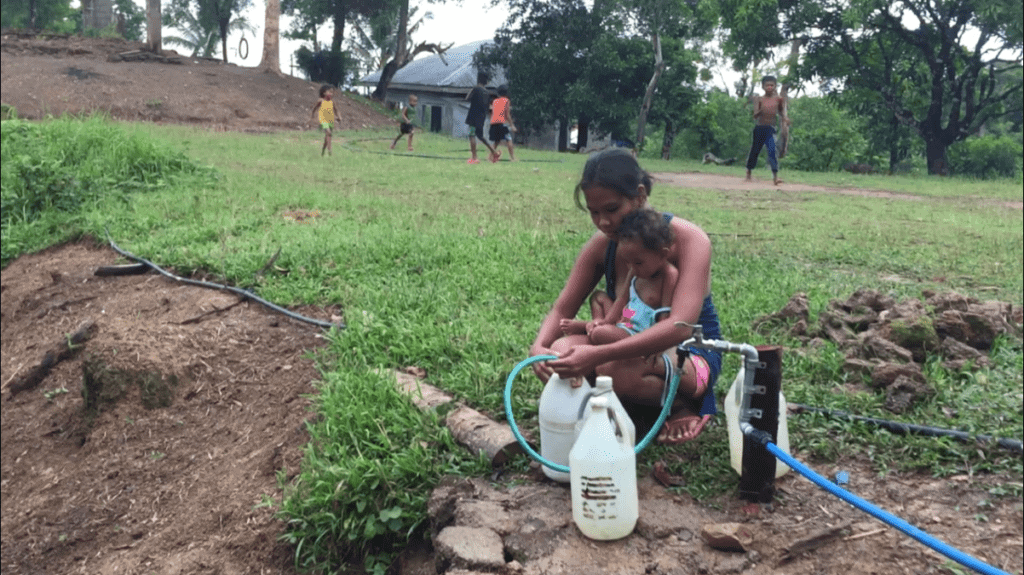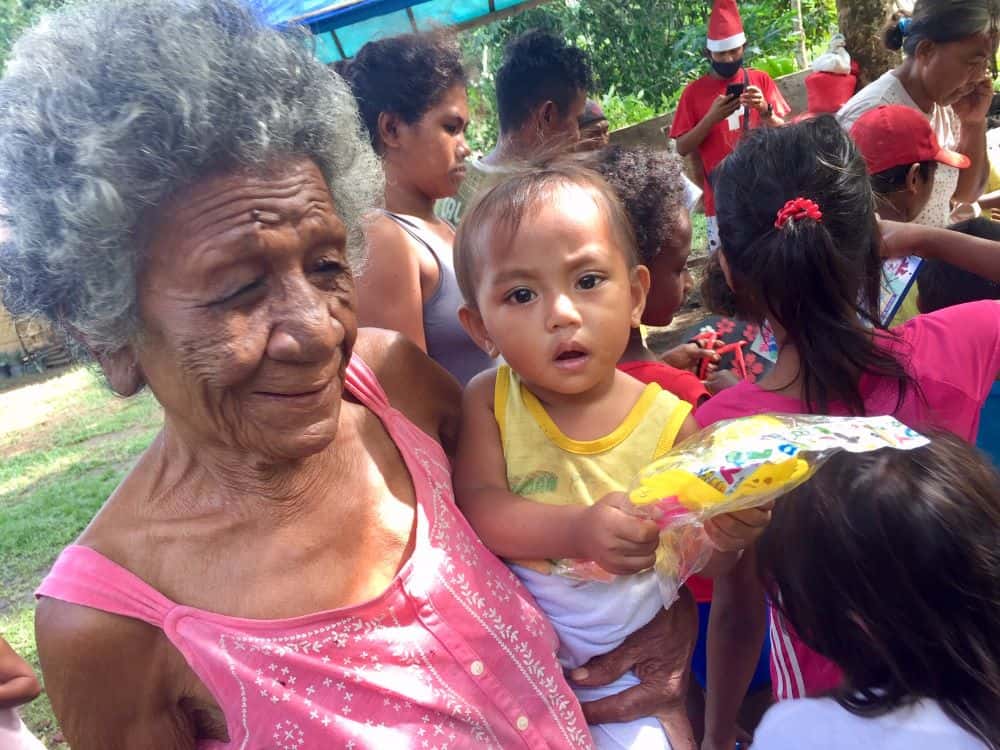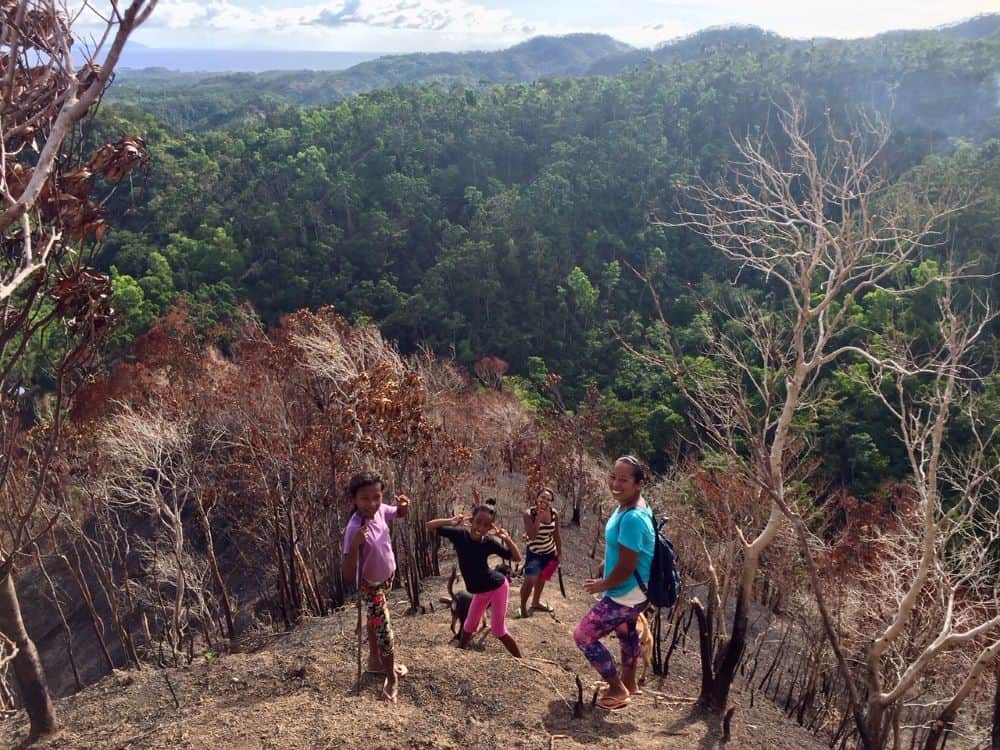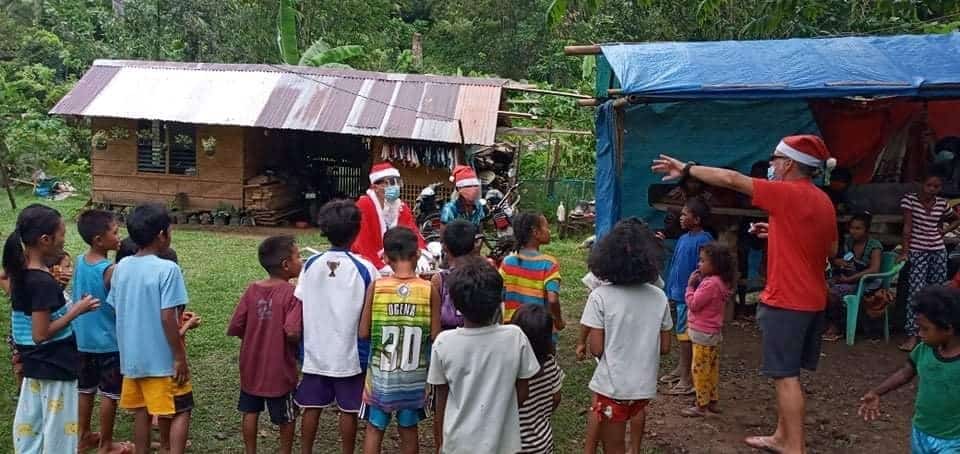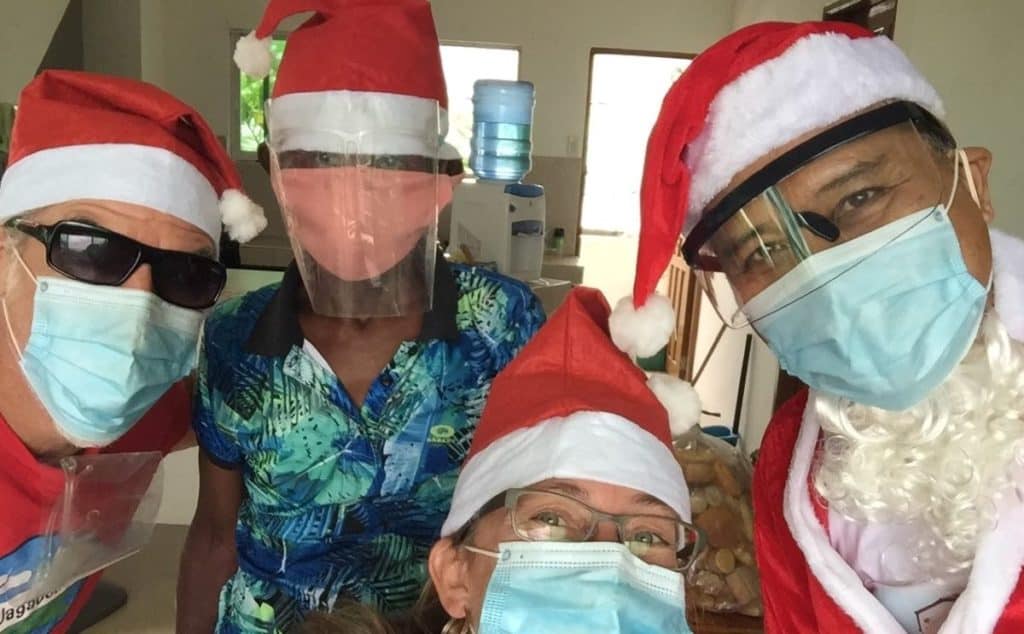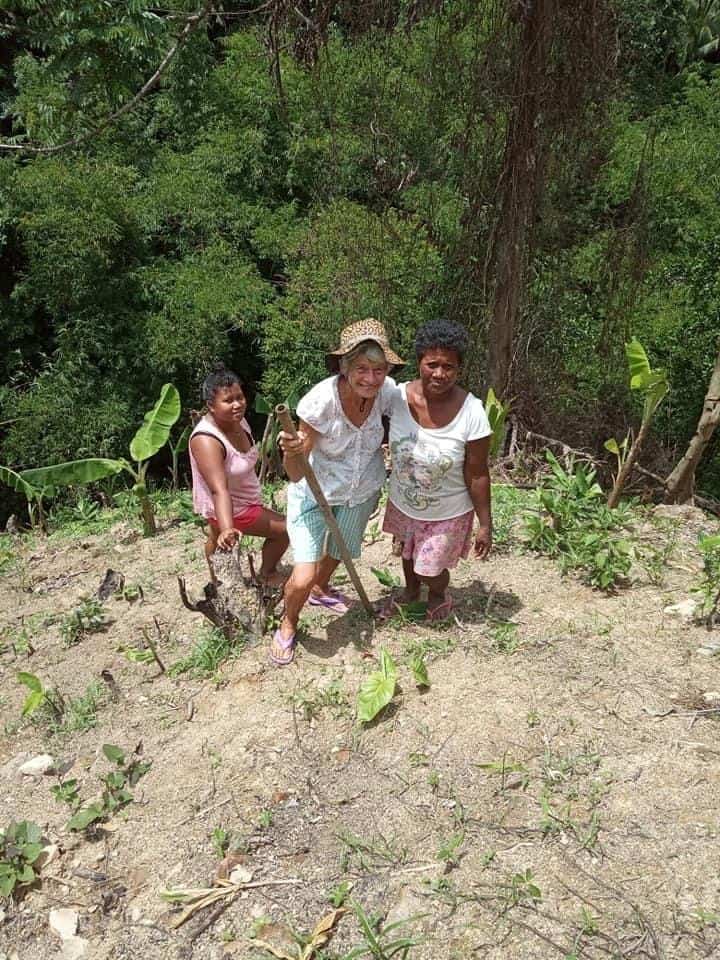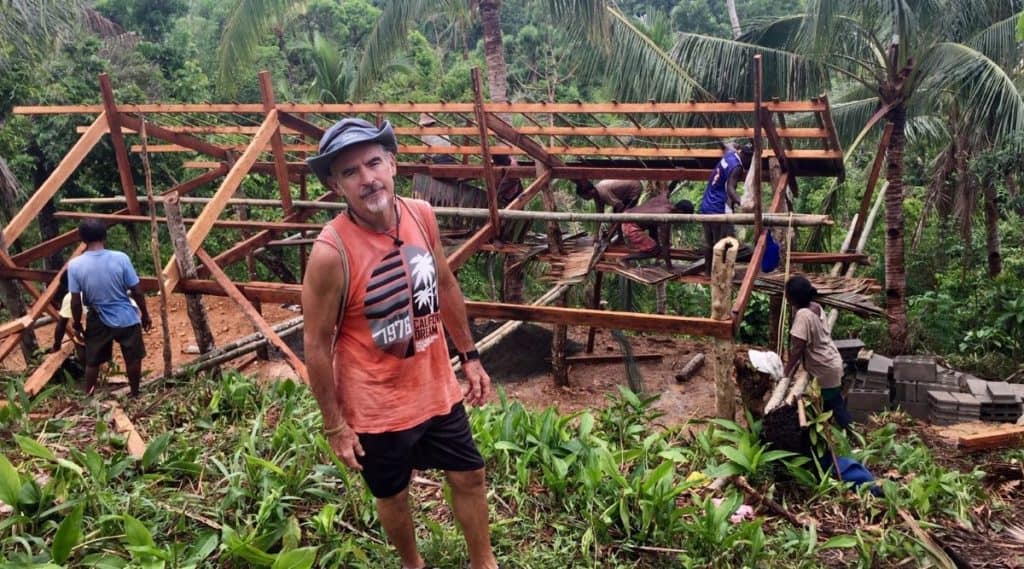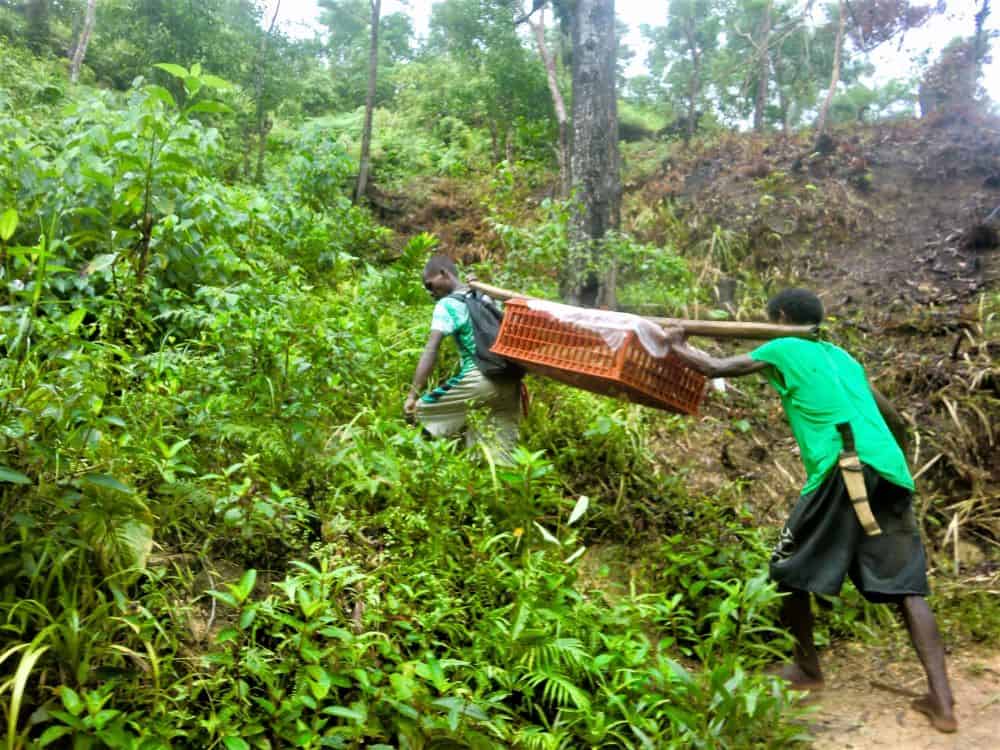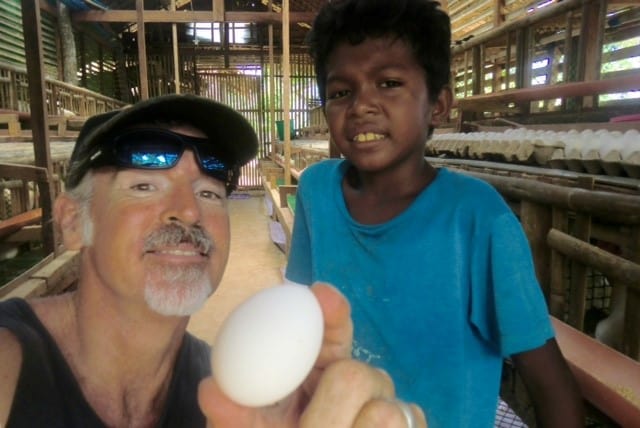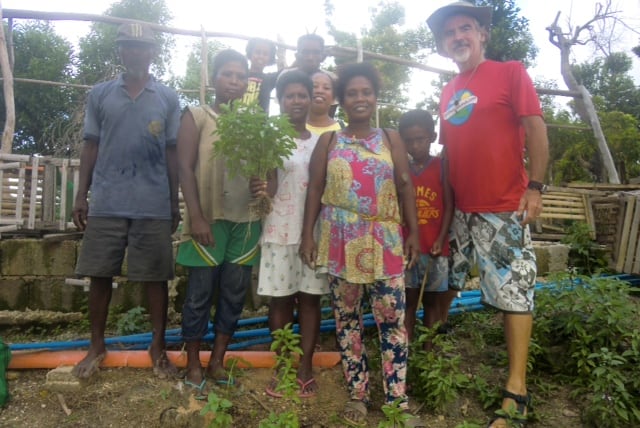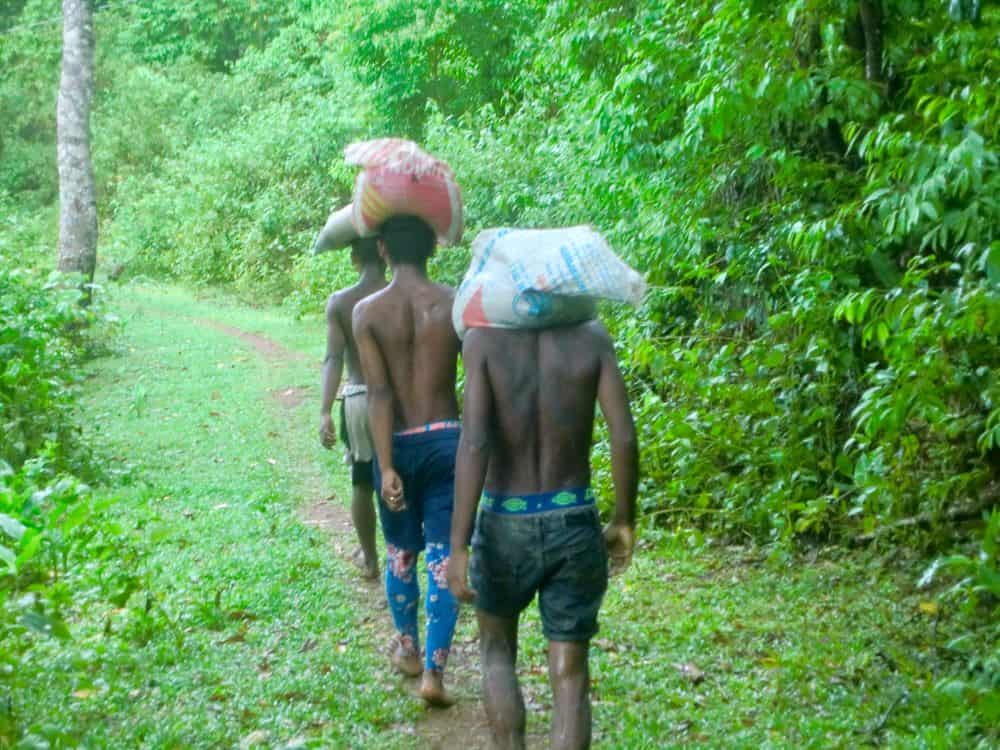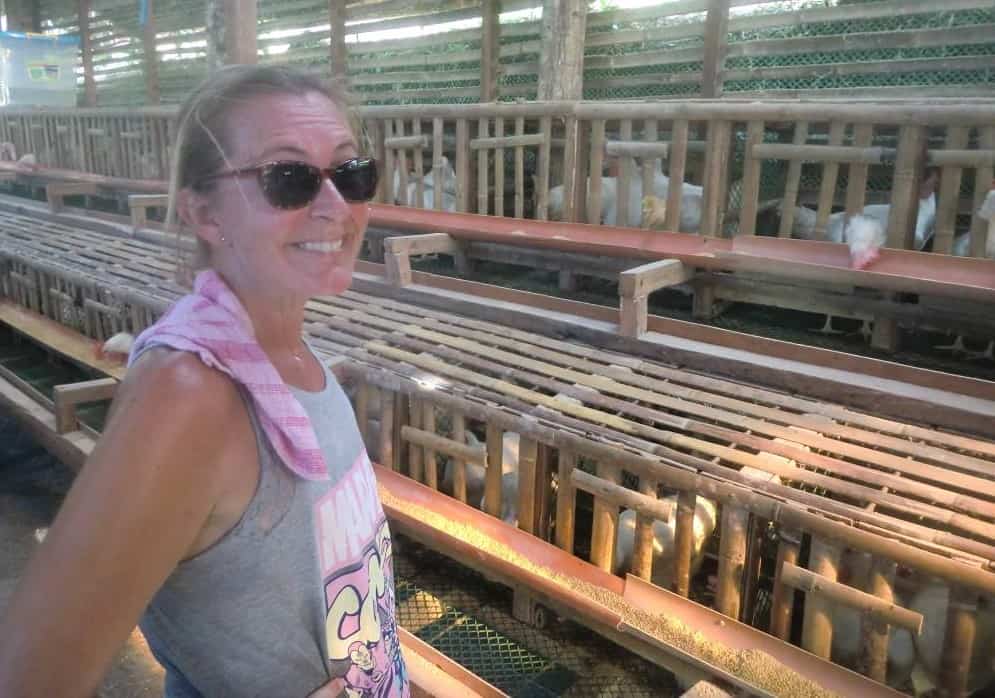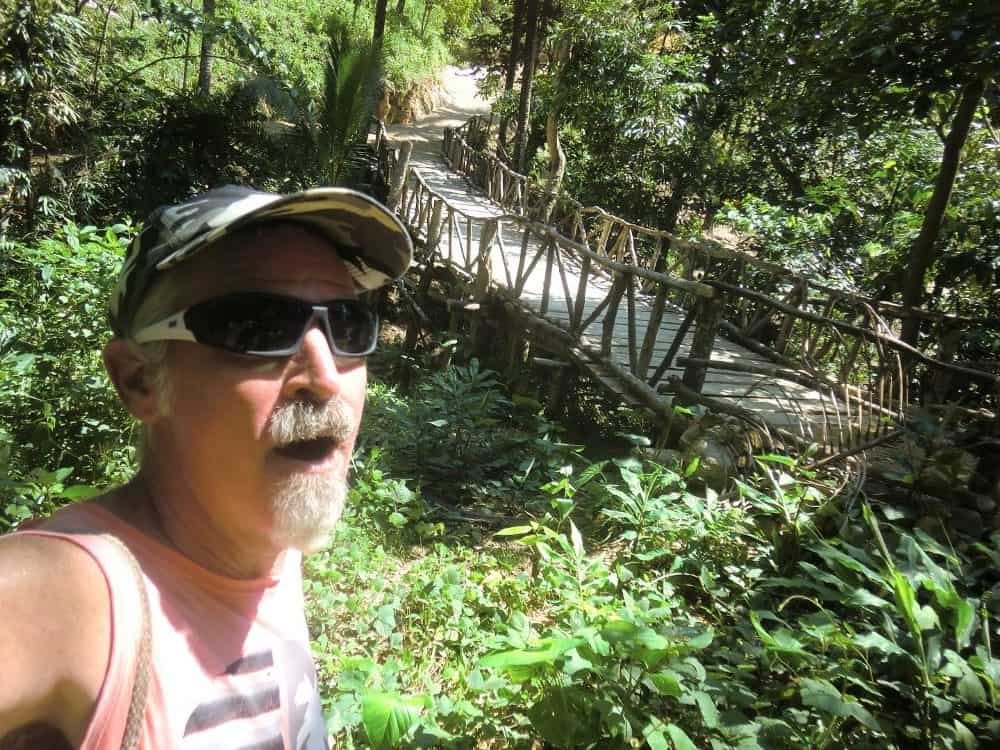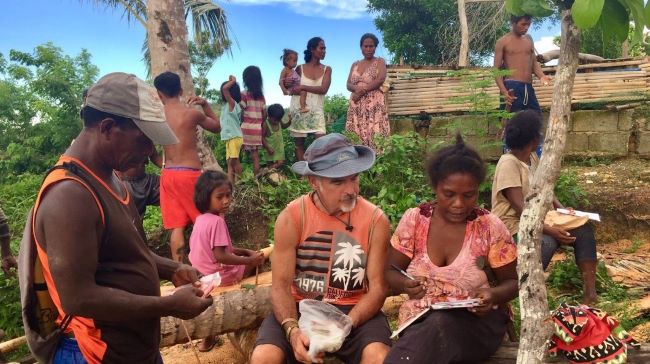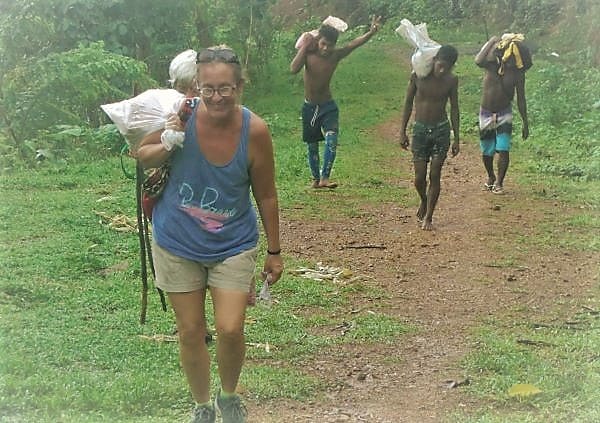This page is special to us. Especially since the Ati tribal chieftain was killed in a horrible boat crash near Boracay Island in the Philippines in 2023.
This page starts with an overview of of the projects we Earth Vagabonds did for the indigenous Ati tribe in mainland Malay, on Panay Island.
Then we cover details of on the death of the Chief.
And then, every post about our work with the Ati from our two pandemic years in the Philippines is linked from this page.
Overview of Ati projects for Kurong Village
We met our Ati friends by chance, luck, fate — whatever you want to call it — at the beginning of the COVID-19 crisis.
When we learned they had a village without water and electricity, we decided to help. The Chief most wanted easier access to drinking water for his marginalized tribe. We determined that first we had to bring electricity to the village so that we could install a water pump in their water source at the bottom of a small mountain.
We also did a lot more for our Ati friends.
Ati projects by Earth Vagabonds & donors
- Drinking water
- Electricity
- Henhouse to provide/sell eggs
- Gardens to grow food
- Fruit trees for food and landslide prevention
- Fishing boats and gear
- Footbridge for easier village access
- Community center rebuilt typhoon shelter
- Hoop, swings, sunset seating
- *Salaries paid to Ati for all projects
Where did we get all this money to help these people? Some of our 2k per month budget was unused during the pandemic, since we were not traveling. Also, we had wonderful and generous overseas donors.
We keep in touch with our mainland Ati friends, and we grieve the loss of Chieftain Ernesto Coching along with our Ati brothers and sisters.
Ati Chieftain Ernesto Coching killed in boat crash
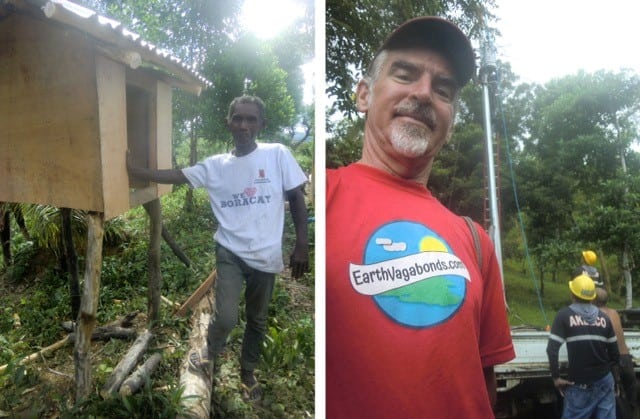
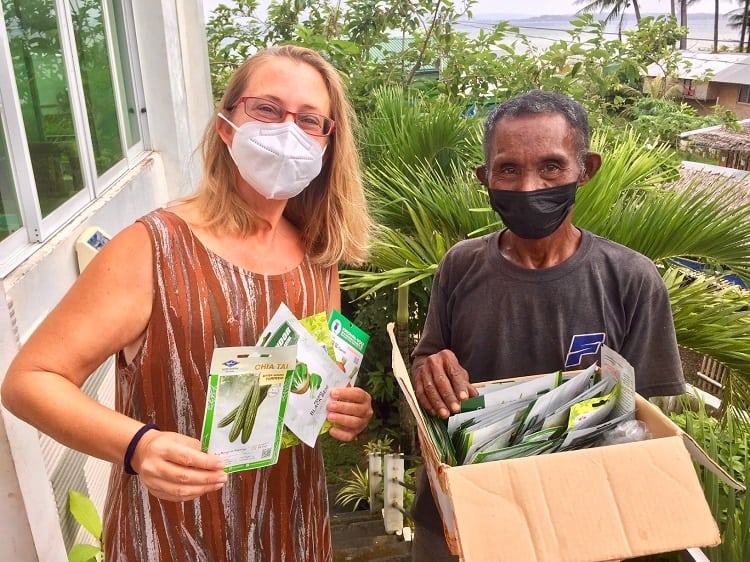
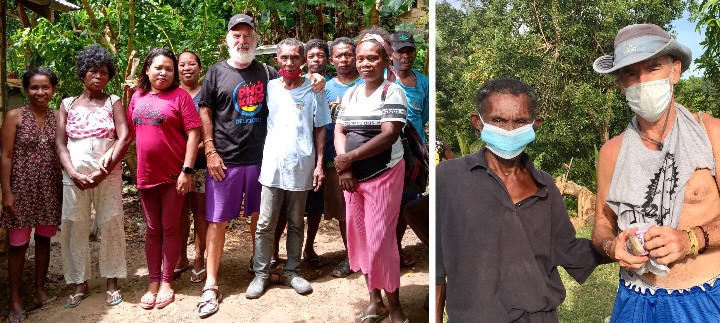
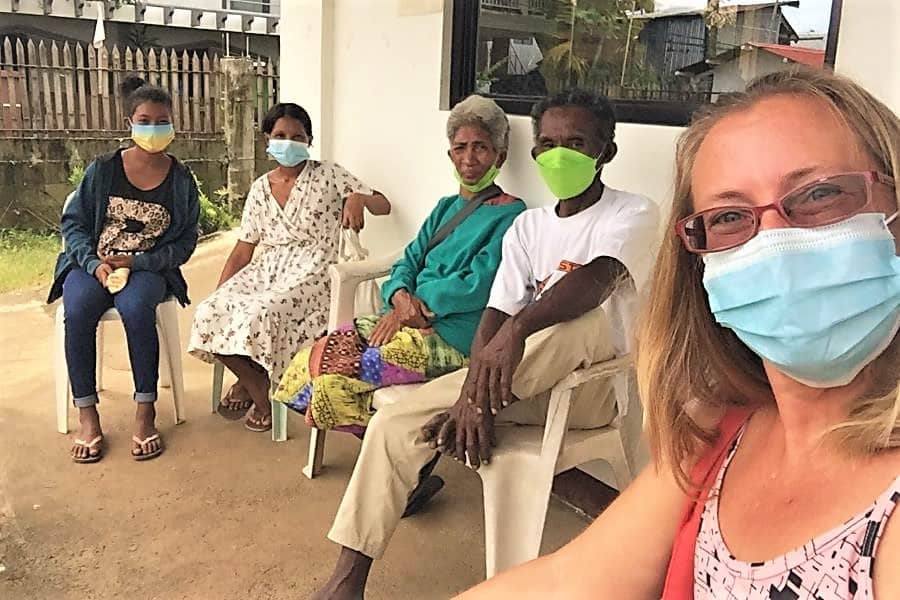
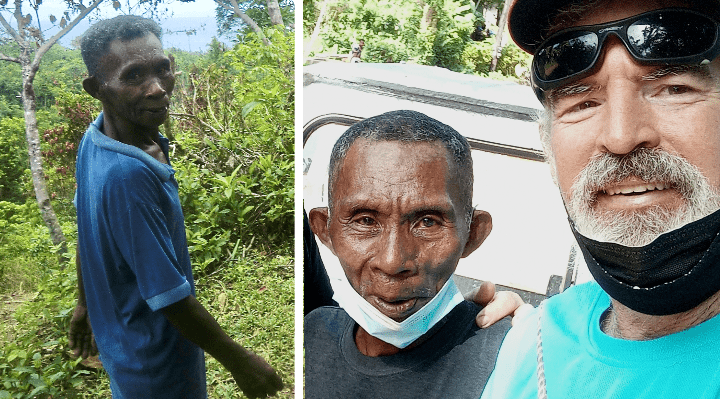
The story of the chief’s death is one for the ages.
Theo wrote about the horrible boat crash that killed him, and that post is here.
Ellen posted about it publicly on her personal Facebook page, which follows.
Excerpt from Ellen’s Facebook post
… The driver of a speedboat with tourists bound for a luxury resort hit the Chief’s modest native fishing boat. The boat was destroyed. The Chief and his son-in-law Ricky were thrown into the water.
The speedboat driver left the scene — and took the tourists to an exclusive resort.
More than an hour later, the speedboat went back. Ricky was rescued. The Chief was gone. Divers looked for his body for two days in the sea between Boracay Island and mainland Malay. They finally found the Chief’s body today.
Police arrested the driver. The case is ongoing in Kalibo, the capital of Aklan Province.
The speedboat is owned by a multi-billion dollar hotel and resort company company — Shangri La. No public comment yet, that I’m aware of, from the luxury business about its employee’s disregard for a human life.
The formerly nomadic Ati tribe lives on Boracay and Panay islands in the Philippines. Many years ago when tourism took off, the Ati were given a tiny part of Boracay Island on the backside — away from the powdery white beaches that make it a top vacation destination. Other tribe members moved to ‘mainland’ Malay.
The mainland Malay Ati were given tough land. Much of it is steep terrain with no infrastructure. The Ati were marginalized — sort of like Native Americans.
You can see beautiful Boracay Island from the top of their small mountain ‘reservation’, a constant reminder of a lost past.
Before the pandemic, many Ati were day laborers. They loaded boats with supplies for tourists who vacationed on their ancestral land. A few men, including the Chief, drove ‘tuktuks’ – motorcycle-carts that are taxis. Jobs all dried up when the coronavirus stopped tourism.
We (me, Theo, and Mom Diane) decided to help the Ati when we were “stuck” in the Philippines during COVID. We had a team of helpers and donors: good and kind Filipinos and foreigners- some strangers, some family and friends.
First, we build a hen house at the mountain-top Kurong Village to get cash in their hands. Egg sales gave the Ati a meager profit, but at least it was something.
Next, we brought *electricity to the village. The Ati in Kurong (one of several mainland villages) were delighted over lights and music.
The third major project was to bring *drinking water to Kurong. That was the Chief’s number one wish when we met him— to get his people in Kurong running drinking water.
All supplies for all projects had to be carried up the small mountain. No roads, just trails.
There were a few other projects, too. Tree planting, typhoon shelter repair, a playground, a new foot bridge over their tough terrain. Boat repairs, fishing line, gardens, bags of rice. Medical tests, tanks of gas, weaving supplies, Christmas presents, and more.
It seems like a dream. Did we really help some of the poorest people on the planet that much? Yes—— and the Chief helped us, too. It was humbling and gratifying to be of service to marginalized people. We are members of the same team. Humanity’s team. I think of these people, and the latest gadgets and fashions seem absurd.
Chief Ernesto Coching was a good man. He was kind. He cared so deeply about his tribe. He made important decisions on all projects. I think the Chief looked happy when he accomplished things with Theo, who knew him way better than I.
I’m so angry at the injustice of this. It is such a tragic story. Indigenous man pushed off his land, given tough terrain. A cab driver and a fisherman (who fished to eat) hit by a speed boat with well-to-do tourists and then left to drown as a relative survives and witnesses utter disregard for their lives. Makes me sick.
“Shangri La” means “a remote beautiful imaginary place where life approaches perfection.”
May the Chief rest in peace in utopia.
Death update – March 2024
The Chief’s family has an attorney. They are trying to sue Shangri-La for damages.
But the Philippine court system is incredibly slow and there is no timeline on if their case might reach a settlement, or when their case might be heard.
Ati blog entries from our time in the Philippines
Below you will find every post we ever wrote involving our projects and our friends. The list starts at the beginning: how we met this beautiful indigenous tribe.
Here are all blog posts we’ve written involving our Ati friends.
We are forever changed.
-
Indigenous Ati people in the Philippines
A lucky beach meeting turns into an opportunity to meet and help an indigenous tribe.
-
Thinking of Ati tribe one rainy night
Dry, fed, internet connected. Luxuries not lost on Tedly.
-
Ati community projects will improve lives
Working to bring electricity to the Ati tribe.
-
Building a chicken coop with the Ati people
Working for a sustainable future.
-
Carrying cinder blocks up mountainside with indigenous Ati tribe
A weighted hike to help our fellows.
-
Payday for hard-working Ati people in Malay
A rewarding pandemic experience.
-
Ati donations will go a long way in Malay, Philippines
You asked how to donate. Here’s how.
-
Sincere Thank You for the Ati donations!
Your generous donations really will make a difference!
-
Ati hen house project: Slow, steady progress
One stick at a time, by hand, to rebuild a chicken coop.
-
Ati payday for hard work, and a personal note
Ati chicken coop tour; breast cancer diagnosis anniversary.
-
Chicken shopping for Ati henhouse on mainland Malay
Chicken shopping. For an indigenous tribe. In a pandemic. True story.
-
Pandemic in paradise; Tedly’s birthday; Ati & virus updates
A peaceful day in a turbulent world.
-
Help with medical bills for Ati; Tedly grateful for good health
Some people needed urgent medical care.
-
Earth Vagabonds expense report for June 2020
We’ve never ‘given away’ so much money.
-
Pandemic walks with Ati soothe soul, seem surreal
Tedly goes back to an earlier time and easier way of life.
-
Chicken order for Ati henhouse & some travel news
Egg-laying hens will be delivered.
-
Supply shopping with Ati – a Philippine indigenous tribe
Tedly, the Ati chief and Ati secretary take many trips to town.
-
Sore feet, beer & boats, haircuts at home
Tedly ‘works’ hard in early retirement, so he put his sore feet up this weekend.
-
Progress, predators, power on ‘Ati mountain’
The chickens are coming soon, and other projects have started.
-
2 steps forward, 1 step — sideways
Obstacles can be overcome with consistent effort.
-
$7 new customer fee for electricity to Ati village causes angst
A kind offer turns angst into jubilation.
-
Supply shortages hit Malay, Aklan
New challenges to overcome.
-
Pride over Ati work on sustainability projects
Hard-working Ati are fast learners.
-
Ati project & pandemic stress reliever
Ellen sees Tedly needs a break.
-
Indigenous Ati to get electricity in upper village
Now we wait for the electric company.
-
Jackpot in Kalibo: helpful stores for foreign visitors
From giant stores to micro businesses.
-
Ati Chicken delivery on God’s time, not ours
There’s been a slight delay.
-
Chicken soup for the soul, Ati style
If it’s God’s will, there is a way through.
-
Great news: Ati eggs for sale!
We have eggs. Lots of eggs — already!
-
Ati chicken update: 1 death, many eggs
A little bad news, a lot of great news.
-
Without electricity yet, Ati solar light works for now
Let there be light, for more eggs and income.
-
Days of relaxation and rain — and anxiety
Beaches and chickens and letting go.
-
Measurements for electricity to upper Ati village in mainland Malay
Tedly is up for the challenge.
-
The other Ati project: drinking water improvements
Where there is a will, there is a way.
-
The news never stops – even on bed rest!
Ati eggs, new American neighbor, fish scores, back to Boracay & bed rest.
-
Fresh egg competition for indigenous Ati
Free markets are alive and well on Panay Island.
-
Egg economics: Sobering summary of Ati project
Costs, profit breakdown.
-
Christmas season in the Philippines starts in September
Tedly is Santa’s helper.
-
Kalibo COVID-19 transmission, ferry confusion, Ati cotillion
The way we locally traveled just last month is now changed.
-
Weekend update from paradise: tourists, dentist, party
Boracay beach visit extended.
-
Poles prove power project progress for Ati tribe
Electricity is coming to indigenous Ati homes.
-
Malay resident cards, getting comfortable, Ati update
No vagabonding for now — we are settling in.
-
Back on budget for September 2020, finally
Our biggest expense again: gifts to needy Filipinos.
-
Shared wealth in the Ati world
My humanitarian husband is my hero.
-
Power progress for Ati tribe in Malay, Philippines
Theo is exuberant over what he witnessed.
-
Typhoon approaches, Mom Diane’s plans, Ati power
Hoping for the best on all fronts.
-
Ati tribe in upper village has power in Malay, Aklan!
The most inspiring story you’ll read all week.
-
Budget breakdown: October 2020 in the Philippines
Did we spend less than our 2k budget?
-
Theo studies hydraulic engineering (really!)
He could use a little extra help.
-
Thanksgiving dinner and holiday shopping trip
Theo kicks off the American holiday season – in the Philippines.
-
Updates: QR codes, Santa, Ati, life in the Philippines during a pandemic
Keepin’ the party goin’.
-
A good thing happened in 2020 – we got to know the Ati indigenous tribe in the Philippines
See some photos never shared before now.
-
Early Christmas for Ati children in Malay, Philippines
Something for everyone.
-
Updates from pandemic paradise in the Philippines
Beach walks, movies, eyeglasses, Ati, and more.
-
COVID death on Boracay, community pantry controversy
As Boracay sits empty without tourists, some Filipinos are simply desperate.
-
Ati water pump project is HUGE success!
Drink freely, Ati friends!
-
Amazing Ati bridge engineering. You gotta see this.
Theo has been busy with more than just the water pump project.
-
Real talk update on Independence Day
Virus, vaccinations, variants, vacations.
-
The $7 electric bill
Pump talk with Tedly.
-
Next project with Ati tribe: Roof repair
Tedly’s crew is back in action.
-
Monsoon showers, more spigots, & customer service
Ati project update in rainy season.
-
Victory gardens for Ati tribe & Filipino friends
Planting plan to help sustain people.
-
Concrete progress in Kurong Village
Our Ati friends are grateful for ongoing help!
-
A truck full of trees for the Ati
Gifts that will bear fruit.
-
Big tree brigade to Kurong Village
Ati children get involved in this sustainability project.
-
Ati tree tale trilogy
Part 3 of planting fruit trees with our indigenous Ati friends.
-
Sprouting seeds, growing hope with our Ati friends
Back to basics for food security.
-
Water slide, water work, water help for Filipinos
A slip-‘n-slide, an overflow, a hydraulic consultation.
-
Theo channels his inner gamer in Philippine FarmVille
Flashback to the Facebook game.
-
Art, homes, lives; duality and unity
A crazy artist, poor Ati, homeless refugees and me — we are all the same.
-
Smoke on the Water, Stairway to Heaven, & Thunderstruck
Rockin’ out more Ati improvements.
-
Ati village now features hoop, swings, sunset seating
A sense of pride, community, and fun in Kurong Village.
-
Pump panic in Ati Kurong Village
Juli saves the day & Theo gets emotional.
-
Growing greens update
Pandemic farming with the indigenous Ati tribe.
-
Ati fishing refurbish report
Another Ati refresh moves forward.
-
I said ‘No’ to the Ati
Theo didn’t like this request.
-
The good, the bad, and the ugly
Updates from Malay, Aklan, Philippines.
-
Fishing nets for our Ati friends
Another self-sustaining effort
-
Extraordinary Ati weaving projects underway
See what our Ati friends can make with these tools!
-
Travel lifestyle interrupted; God’s will confounds
A week of ups and downs.
-
Seasonal celebrations, a full social calendar, another special year
Theo’s third Christmas and New Year in the Philippines.
-
2021: A final roundup from the Philippines
What a year!
-
So many tears
Theo is emotional about leaving the Philippines.
-
Shocking loss of unlikely friend – the indigenous Ati Chief
Theo is honored to have known him.
-
Philippine friendships endure beyond pandemic
Tedly is welcomed back where Earth Vagabonds lived for a time.
-
Return to Kurong – the Ati mountaintop village we helped in pandemic days
The ‘promised land’ to an indigenous tribe in the Philippines.
-
Earth Vagabonds work for Ati tribe – again – during budget slow travel adventure
Back to a remote village where we brought drinking water and electricity during the pandemic.
